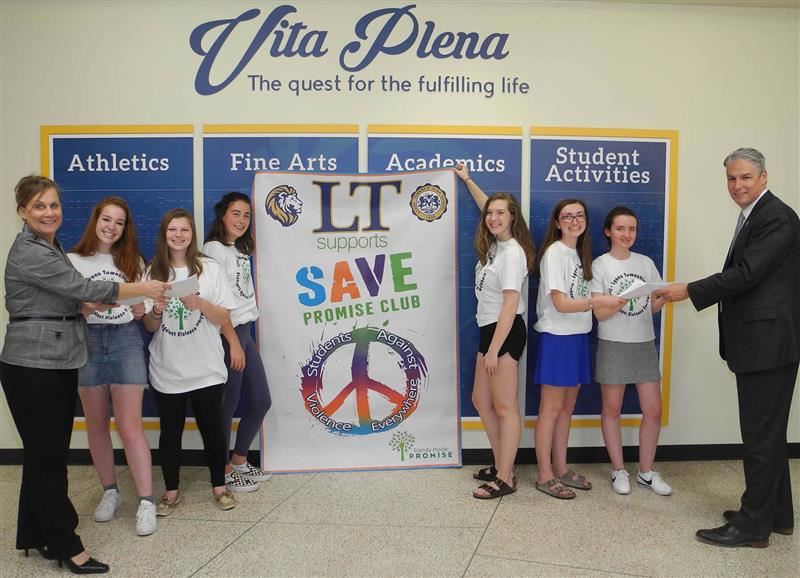On school safety, LT Save Club promotes alternative to gun control
Members of the LT Save club pose with administrators Dr. Waterman and Therese Nelson in front of a sign for their club
August 29, 2018
Only hours after holding its first ever meeting Aug. 28 at the NC Cafeteria, two members of the new LT Save Promise Club gathered for a forum at the La Grange Park Public Library to tell the local affiliate of the Moms Demand Action advocacy group about what it is like living as a student in an atmosphere so overshadowed by gun violence—and also how they wish to work to address the topic.
“I think it’s important that we all unite with this issue, instead of making it a divided topic between liberals and conservatives,” club co-founder Ella Finnegan ‘20 said. “That’s what Sandy Hook Save Promise [clubs] do. It rises above that issue, which I think is important.”
In the wake of the school shooting at Marjory Stoneman Douglas High School in Parkland, Fla., that killed 17 people last February, much of the discussion about preventing gun violence has been centered on the need for greater gun control regulation.
However, the leaders of the Save Promise Club attempt to separate themselves from the divisiveness of the current discourse on gun control, instead focusing on how fostering a positive community at LT can help stop violence before it happens, co-founder Molly Davies ‘20 said.
“I think the culture we’re trying to promote is one where everyone has friends, everyone has somebody to talk to in their class or in the hallway or sit with at lunch,” Davies said. “Because of that, we can hopefully eliminate any feeling of need for violence at all, whether that be with guns or just with fighting.”
The club’s first meeting at NC drew around 30 students, the founders say, with a second meeting for SC students occuring on Aug. 29 in the sophomore cafeteria. But even prior to the clubs first meeting, 300 students signed a pledge against gun violence, which Finnegan thinks “speaks a lot to the amount of people who are committed to preventing” gun violence at LT.
Leaders of the new Save Promise Club—an affiliate of the Sandy Hook Promise Organization, founded in response to the 2012 Sandy Hook Elementary School shooting in Newtown, Conn.—said that the chapter at LT hopes to apply the “proven” strategies developed by the greater Sandy Hook Promise Organization to the halls of LT.
“Sandy Hook Promise has its sole purpose of preventing violence of any kind in our schools and our community before it happens,” Save Promise Club co-sponsor Pat Callahan said. “What we want to do is use the Know the Signs Program that Sandy Hook Promise has developed and embed them into our school environment.”
According to the organization’s website, the Know the Signs Program is based on four things: identifying signs of suicide, saying something when noticing signs of those “who may be a threat to themselves or to others,” assessing and responding to potential threats and building a more inclusive school atmosphere.
Callahan said that the Save Club addresses gun violence in a more proactive manor than more recent reactive steps taken by schools like increasing security.
“As a parent of high school and college kids, I would much rather have one of my kids listen to one of our Sandy Hook Save programs than to learn how to crouch over in the corner in a lockdown drill,” said Callahan, who is additionally a paraeducator in the math and science department.
But Callahan also said that the lockdown drills and added measures are “necessary evils” that have to be utilized coupled with the efforts spearheaded by the Save Club.
“The approach [of the Save Club] is a proactive approach to violence, not reactive,” she said. “I think schools throughout the country are taking the easier path of reactive things, but I think the Know the Signs program brings a proactive approach to preventing these violent acts before they happen.”
While many people disagree on what is the right route to correct violence in high schools, Finnegan said that the crux of their efforts are based on making sure students feel safe where they attend school.
“I think this is so important to our community because students should be able to focus on school and not need to worry about their safety,” Finnegan said. “In order for kids at LT to do well, they don’t need the stress of whether or not they are going to be safe when they walk into the doors.”





















![Movie poster for '[Rec]" (2007).](https://www.lionnewspaper.com/wp-content/uploads/2023/04/rec-640x900.jpg)



